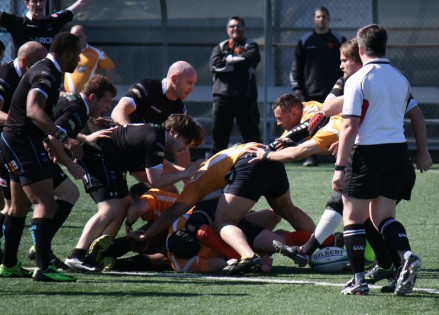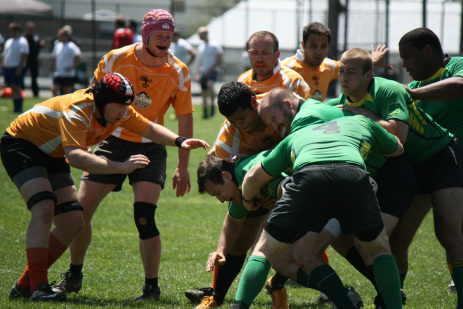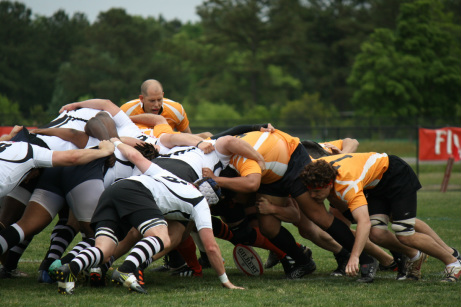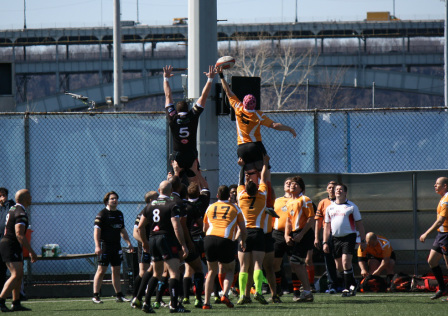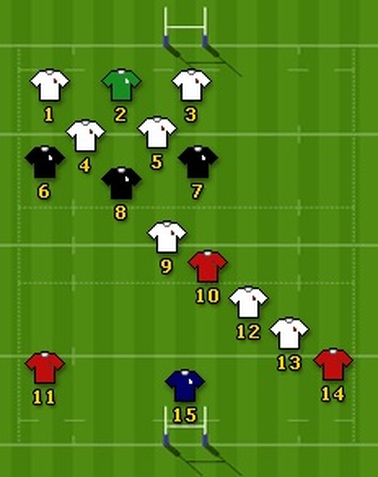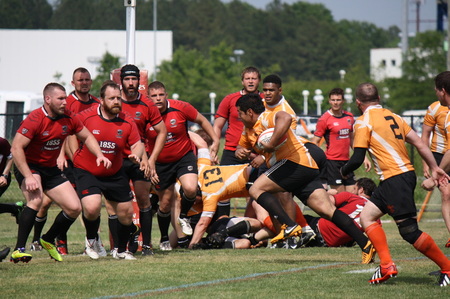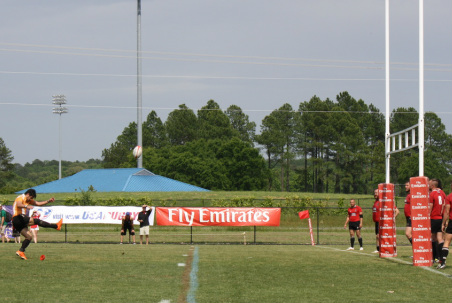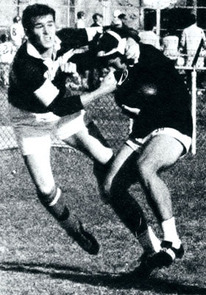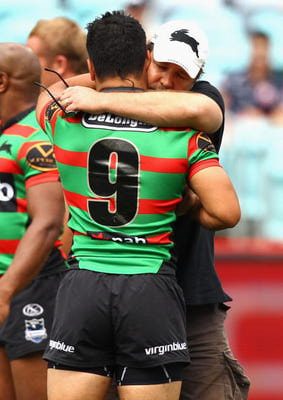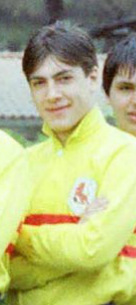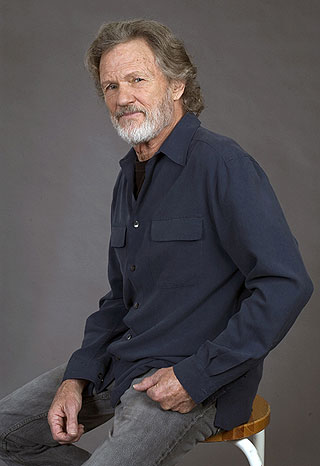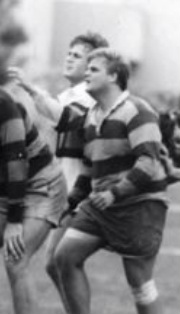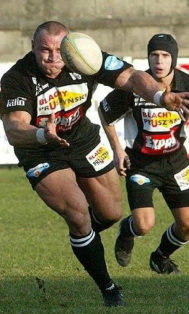how to Play Rugby:
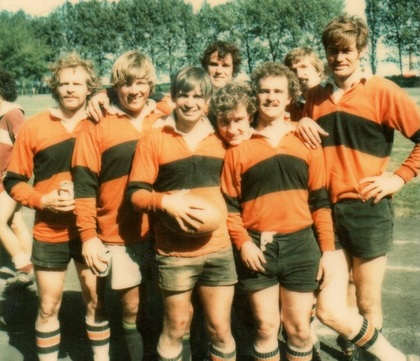
The game is played with two teams, each consisting of fifteen players. Each team can carry, pass or kick the ball to the end zone to score as many points as possible. The team scoring the greater number of points is the winner of the match.
The two teams compete for two forty minute halves with a five minute halftime. One referee controls the match with the assistance of two touch judges. There are no time outs, except at the referee's discretion where he can allow one minute for an injured player to decide whether or not to continue to play.
Each team is only allowed seven replacements per game. Six of the replacements are at the teams discretion and a seventh for injury. Once a player is substituted, he can not rejoin the game. The only time a player can rejoin the game is if he was temporarily substituted for a blood injury, but he must return within ten minutes of the substitution or be permanently replaced.
The game begins with a kickoff which is taken from the center of the field. The team with the ball makes every effort to score a try once the ball is in play. A try is scored when a player touches the ball to the ground in the opponent's in-goal. The team is then awarded five points. After a try is scored, the team is given the opportunity to score a goal by kicking the ball over the opponents cross-bar and in between the goal posts, scoring an additional two points, also known as conversion points. The ball must be kicked from a line perpendicular to where the ball was touched down. If the opposing team commits a penalty at any time, the offended team can attempt a penalty kick for three points, either at the goal or a drop kick at the goal from anywhere in the field of play.
During the game, players move forward towards their goal, however the ball can not be passed forward. The player must pass the ball backwards to his teammates while moving forward. Forward progress of the player carrying the ball may be impeded by tacking that player. Once a player is tackled, he must immediately pass or released the ball and move away from it.
The two teams compete for two forty minute halves with a five minute halftime. One referee controls the match with the assistance of two touch judges. There are no time outs, except at the referee's discretion where he can allow one minute for an injured player to decide whether or not to continue to play.
Each team is only allowed seven replacements per game. Six of the replacements are at the teams discretion and a seventh for injury. Once a player is substituted, he can not rejoin the game. The only time a player can rejoin the game is if he was temporarily substituted for a blood injury, but he must return within ten minutes of the substitution or be permanently replaced.
The game begins with a kickoff which is taken from the center of the field. The team with the ball makes every effort to score a try once the ball is in play. A try is scored when a player touches the ball to the ground in the opponent's in-goal. The team is then awarded five points. After a try is scored, the team is given the opportunity to score a goal by kicking the ball over the opponents cross-bar and in between the goal posts, scoring an additional two points, also known as conversion points. The ball must be kicked from a line perpendicular to where the ball was touched down. If the opposing team commits a penalty at any time, the offended team can attempt a penalty kick for three points, either at the goal or a drop kick at the goal from anywhere in the field of play.
During the game, players move forward towards their goal, however the ball can not be passed forward. The player must pass the ball backwards to his teammates while moving forward. Forward progress of the player carrying the ball may be impeded by tacking that player. Once a player is tackled, he must immediately pass or released the ball and move away from it.
Rugby Vocabulary:
Blindside - from a set piece, this is the short side of the field
Cap - anytime a player plays in a match he/she is technically awarded a cap
Drop Goal - a kick at the posts taken at anytime a side is close to their own try line- if successful it scores three points but the ball must hit the ground before being kicked
Garryowen - a kick which is high in the air
Grubber - a kick of the ball which cause the ball to bounce and roll along the ground
Knock On - losing, dropping, or knocking the ball forward from a player's hand resulting in the ball being awarded to the other team in a scrum
Mark - a location on the pitch designated by the referee as the location a scrum should come together
Offsides - during rucks, scrums, lineouts, and mauls an imaginary line is present over which any player crossing before the set piece is completed committs a penalty
Penalty - any number of infractions or violations which award the other team a kick
Penalty Try - the awarding of a try due to a flagrant violation by an opposing side that prevents an obvious try from being scored
Place Kick - a kick of the ball resting on the ground, placed in an indention in the ground, from a small pile of sand, or from a kicking tee
Referee - the sole judge and timekeeper of the game
Restart - the kick restarting play after a half or after points are scored
Touch Judge - an official posted on each side of the pitch to mark the spot where balls go out of touch and to judge kicks at goal
Cap - anytime a player plays in a match he/she is technically awarded a cap
Drop Goal - a kick at the posts taken at anytime a side is close to their own try line- if successful it scores three points but the ball must hit the ground before being kicked
Garryowen - a kick which is high in the air
Grubber - a kick of the ball which cause the ball to bounce and roll along the ground
Knock On - losing, dropping, or knocking the ball forward from a player's hand resulting in the ball being awarded to the other team in a scrum
Mark - a location on the pitch designated by the referee as the location a scrum should come together
Offsides - during rucks, scrums, lineouts, and mauls an imaginary line is present over which any player crossing before the set piece is completed committs a penalty
Penalty - any number of infractions or violations which award the other team a kick
Penalty Try - the awarding of a try due to a flagrant violation by an opposing side that prevents an obvious try from being scored
Place Kick - a kick of the ball resting on the ground, placed in an indention in the ground, from a small pile of sand, or from a kicking tee
Referee - the sole judge and timekeeper of the game
Restart - the kick restarting play after a half or after points are scored
Touch Judge - an official posted on each side of the pitch to mark the spot where balls go out of touch and to judge kicks at goal
Rugby Positions:
|
A rugby team has 15 positions. Each one wears a specific number and has individual responsibilities.
Forwards: These guys tend to be the heavyweights of the team because they do a lot of the pushing, pulling, and scrambling and use their bulk and strength to win possession of the ball.
Backs: These are the smaller, faster players that run or kick the ball down the field once possession is gained.
|
Scoring:The aim of rugby is to score more points than the opposition. This is done in four different ways:
|
Tackling the Laws of Rugby
Rugby is governed by laws, not rules.
Common Mistakes:
- In a nutshell, when a tackle is made in rugby the requirements are that the tackler releases the tackled player, who then releases the ball so that players who are on their feet can use it.
- Advantage simply means that when one team makes an error the other team can try to capitalize on it, instead of the referee immediately stopping the action. If the players can’t capitalize on the error, play restarts where the original mistake took place.
- Specific offsides laws exist for different phases of play, but essentially players can’t be involved if they’re in front of a teammate who last played the ball or are behind the ball when the opposition has it.
Common Mistakes:
- Offside: A player is offside in general play if he is in front of a teammate who is carrying the ball, or in front of a teammate who last played the ball. It is also illegal to kick the ball to a teammate that is down-field from the kicker.
- Forward pass: An illegal pass to a player who is ahead of the ball; a player is not allowed to pass the ball forward to a team-mate.
- Knock on: If a player drops the ball ‘forward’ – that is, towards the opposing team’s tryline – or loses possession of the ball and it goes forward, a scrum is set, with the non-offending team getting the scrum feed.
- High Tackle: Taclking the ball carrier above the collar, it is illegal to tackle around the ears
- Playing the Person: Tackling or interfering with someone who is not carrying the ball
- Shepherding: Interfering with an apponent who is trying to tackle the ball carrier
- Failure to Release: Not letting go of the ball when tackled
- Foul play: Play deemed by the referee as being dangerous, obstructive, unfair play or misconduct. The offending player is penalized, possibly sent to the sin bin or even sent off.
Still have questions about the game? Check out the Spectators Guide to Rugby from USA Rugby!
Famous Rugby Players
|
President Bill Clinton
He played in England from 1968-1970 and has been called a "rather lumpy, but excellent" second row forward for the Little Rock Arkansas RFC. |
President George W. Bush
He played for Yale during his junior and senior years of college. |
Actor Russell Crowe
He lost is front tooth playing rugby when he was 10. He also played for the First XV for Sydney Boys High School, often rated as one of the best schoolboy rugby competitions in the world. |
Actor Javier Bardem
He played for the Madrid RFC as a flanker then ended up as a prop. On his love for rugby said, "Being a rugby player in Spain is akin to being a bull fighter in Japan." |
|
Musician Kris Kristofferson
He experienced his first dose of fame when he appeared on the cover of Sports Illustrated's "Faces in the Crowd" for his achievemetns in collegiate rugby union, football, track and field. He and fellow classmates revived the Claremont Colleges Rugby Club in 1958. He also played rugby while attending Oxford University on a Rhodes Scholarship. |
Actor Chris Farley
He played rugby at Marquette (he wears the jacket in the movie "Tommy Boy"). He showed up to his first practice wearing baggy shorts and a pink polo shirt. |
Actor Daniel Craig
He played for the Hoylake Union RFC in England. |
World's Strongest Man, Marius Pudzianowski
He plays for Budowlani Lodz, a rugby club in Poland. They are the current national men's rugby champions of Poland. |
When Did All of This Start?
From the 1400's to the 1800's, many different types of football were played throughout Britain. Years later in 1830, it became common to run with the ball and the sport became popular throughout the UK in the 1850's and 1860's.
1857: The first rugby match in Scottland, Edinburgh University vs Edinburgh Academicals
1869: The first rugby match in American, Rutgers vs. Princeton
1871: The Rugby Football Union was formed and held the first international match between England and Scotland.
1875: Oxford vs. Cambridge, teams were limited to fifteen players per side.
1876: Tries did not have a point value, but were used to determine the winners in the event of a tie. America adopted The Rules of Rugby Football which required players who were tackled to release the ball.
1881: Referees introduced at international matches but they only observed from the sidelines along with two umpires.
1891: The RFU declared that all sides limited to 15 players, 2 points awarded for a try, 3 for a penalty goal and conversions and 4 points for a dropped goal.
1896: Referees were given complete control of the game and the idea of "advantage" was introduced.
1908: France won the Olympic Gold Medal in Rugby
1906: Forward passes introduced in America
1920: America wins the Olympic Gold Medal in Rugby
1924: America wins the Olympic Gold Medal in Rugby, the last time rugby is considered an Olympic sport until 2016.
1932: Wing-forwards were required to bind into the scrum and the three man front row was required
1949: Dropped goals were reduced to 3 points.
1958: Penalty kicks were no longer required to travel 5 yards.
1969: The 'Australian dispensation' was adopted, this required that kicks for touch outside the 22-meter line land in the field of play before going into touch, or be returned to the place of kick.
1971: Tries were increased to 4 points, and the Gaelic Athletic Association no longer banned members from playing rugby on the grounds that it was a foreign game.
1992: Tries were increased to 5 points.
1857: The first rugby match in Scottland, Edinburgh University vs Edinburgh Academicals
1869: The first rugby match in American, Rutgers vs. Princeton
1871: The Rugby Football Union was formed and held the first international match between England and Scotland.
1875: Oxford vs. Cambridge, teams were limited to fifteen players per side.
1876: Tries did not have a point value, but were used to determine the winners in the event of a tie. America adopted The Rules of Rugby Football which required players who were tackled to release the ball.
1881: Referees introduced at international matches but they only observed from the sidelines along with two umpires.
1891: The RFU declared that all sides limited to 15 players, 2 points awarded for a try, 3 for a penalty goal and conversions and 4 points for a dropped goal.
1896: Referees were given complete control of the game and the idea of "advantage" was introduced.
1908: France won the Olympic Gold Medal in Rugby
1906: Forward passes introduced in America
1920: America wins the Olympic Gold Medal in Rugby
1924: America wins the Olympic Gold Medal in Rugby, the last time rugby is considered an Olympic sport until 2016.
1932: Wing-forwards were required to bind into the scrum and the three man front row was required
1949: Dropped goals were reduced to 3 points.
1958: Penalty kicks were no longer required to travel 5 yards.
1969: The 'Australian dispensation' was adopted, this required that kicks for touch outside the 22-meter line land in the field of play before going into touch, or be returned to the place of kick.
1971: Tries were increased to 4 points, and the Gaelic Athletic Association no longer banned members from playing rugby on the grounds that it was a foreign game.
1992: Tries were increased to 5 points.
Thank you to John Ager for his contributions to this page.
Information was also taken from "Rugby for Dummies" by Mathew Brown, Patrick Guthrie and Grew Growden, and Wikipedia.
Information was also taken from "Rugby for Dummies" by Mathew Brown, Patrick Guthrie and Grew Growden, and Wikipedia.

